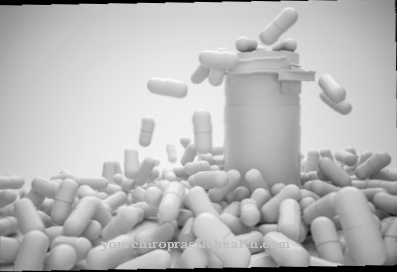Gentamicin is an aminoglycoside antibiotic. It is mainly effective against gram-negative bacteria, but is only used systemically in emergencies due to nephro- and ototoxic side effects.
What is gentamicin?
Gentamicin is an antibiotic from the group of aminoglycosides, which is composed of several substances, the so-called gentamicins. It is therefore a mixture of substances. The sulfate salt of gentamicin is used as a medicinal substance. The first gentamicins were discovered in the Micrononospora purpurea bacterial strain. The different gentamicins are structurally very similar.
Gentamicin has a bactericidal effect and is particularly effective against gram-negative bacteria, but also against staphylococci. It is now only used systemically as a reserve antibiotic, especially in the case of nosocomial infections (so-called hospital infections), as it can cause serious side effects. Above all, the nephro- and ototoxicity should be mentioned here.
When applied topically, these potential side effects are so unlikely that they are negligible. For this reason, gentamicin is widely used in eye drops and eye ointments.
Pharmacological effect
Gentamicin is a very effective antibiotic and can be used to treat various bacterial infections. In practice, gentamicin is only used systemically as an emergency medication because it can cause serious side effects. These include, above all, pronounced nephro- and ototoxicity. These possible kidney and ear damage prevent gentamicin from widespread use as long as other effective antibiotics are available.
For some indications, especially hospital infections (nosocomial infections), however, there is often no other agent available or the other antibiotics available lead to similar or more severe side effects.
In veterinary medicine, however, gentamicin is used very often, which is mainly due to the low price.
The mechanism of action of gentamicin is to prevent the reading of the mRNA on the ribosomes of the bacteria. It does this by binding to the 30S subunit of the ribosomes. If the mRNA cannot be read, the protein biosynthesis of the bacteria is hindered. If there is a high concentration of gentamicin, the human protein synthesis can also be influenced.
When applying gentamicin, it must be ensured that this is not possible orally. Gentamicin must always be administered parenterally.
Medical application & use
Gentamicin works mainly against gram-negative bacteria, but also against staphylococci. It is not effective against anaerobic bacteria, gentamicin is less effective in an acidic and / or anaerobic environment.
In general, gentamicin is a very effective antibiotic and could therefore be used for a number of bacterial infections. However, since there is a high risk of serious side effects, gentamicin is only used systemically in emergencies. It is mostly used in combination with beta-lactam antibiotics.
Indications for the use of gentamicin are endocarditis (inflammation of the inner lining of the heart), severe infections by Pseudomonas, enterococci, listeria, staphylococci and enterobacteria as well as infections by multiple resistant tuberculosis bacteria.
The systemic use of gentamicin must always be carefully weighed against the risk of serious side effects. In the case of prolonged treatment, this weighing must take place again and again. The therapeutic range of gentamicin is narrow: if the plasma level is elevated, the risk of nephro- and ototoxic reactions increases rapidly. The risk also increases with increasing duration of treatment, as the gentamicin accumulates in the kidney cortex. A strict indication and an individually adapted dosage are therefore necessary.
When applied topically, the risk of systemic side effects is low. For this reason, gentamicin is widely used in eye drops and ointments.
In surgery, ball chains containing gentamicin and bone cement containing gentamicin are sometimes used in order to avoid postoperative soft tissue and bone infections. In addition, sponges containing gentamicin are used in various procedures. Gentamicin is ideal here because of its high heat resistance and low allergenic potential.
Gentamicin can also be used against Menière's disease, but is not approved for this use. The dizziness that occurs in Menière's disease can be treated with gentamicin, as gentamicin can destroy sensory cells in the ear due to its ototoxicity.
Risks & side effects
Gentamicin is strongly nephro- and ototoxic. In 1-10% of cases, gentamicin damages the kidneys. This causes damage to the proximal tubule. This is mostly reversible. In combination with other nephrotoxic drugs, the risk increases.
Ototoxic reactions are also common. Hearing damage occurs in 1-3% of cases, and balance disorders occur in up to 14% of cases.
There is no safe dose of gentamicin, but the risk of side effects increases with a higher daily dose and a higher total dose. Thus, there is a higher risk with a longer treatment duration and a higher dose.
Other side effects are neuromuscular blockages. Plasma levels should be checked during treatment with gentamicin.



























